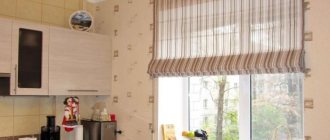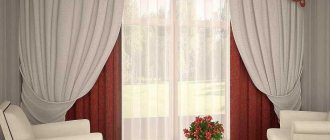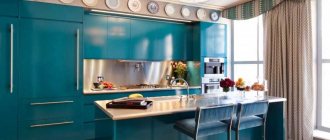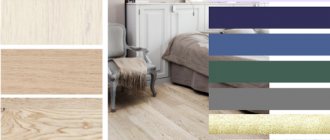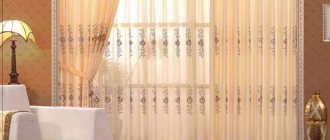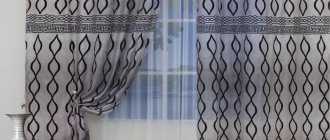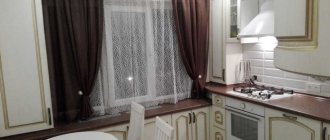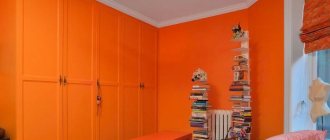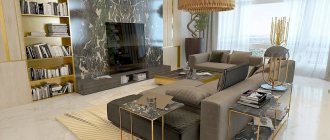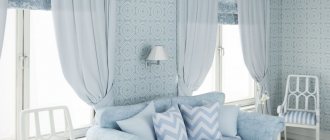Photo gallery more than 40 photos
Amazingly beautiful openwork lambrequins - photo.
Photo gallery
A window opening in the design of exquisite openwork lambrequins looks much more interesting, its appearance radically changes the style of any interior and adds elegance and fashionability to it.
Unusual window decoration is becoming increasingly popular. Beautiful curtains and openwork lambrequins complementing them will decorate any room. With the help of this interior detail, designers are able to transform the most “boring” room beyond recognition. It becomes original: it creates a nice homely coziness or a touch of solemnity appears.
What are lambrequins?
Craftsmen have always used beautiful folds and carved patterns to decorate windows. A panel with lace inserts was attached to a baguette to give the composition more grace.
Openwork lambrequins are not just decoration, they are a functional element that covers the fastening of curtains. Swirl strip strips do a great job of filling the top of the wall near the ceiling. Carved products made from practical materials do not need frequent washing. It is enough to sometimes wipe them with a slightly damp sponge. The felt surface is vacuumed about once a month.
How to care and clean?
Caring for lace lambrequins is not difficult. Carved bands cannot be washed in a washing machine and, in general, try to avoid wet cleaning if possible, but they lend themselves well to dry care. Using a regular clothes brush you can get rid of dust and dirt. Due to the fact that synthetic fabrics are used to make lambrequins, you don’t have to worry about their structure and color saturation.
If the contamination is severe, you can use very little water and washing powder or washing gel:
- Dilute the powder with water until it becomes mushy. There is no need to dilute the gel.
- Remove the lambrequin and lay it on the floor.
- Apply the product to the stain, spread and leave for about 10 minutes. Using a brush, try to remove as much dirt as possible. Do not overdo it, as you may deform the lambrequin.
- Use a soft sponge and water to remove any traces of product from the fabric. Try not to wet the bandeau too much; use a slightly damp sponge.
- Iron the lambrequin several times.
As you can see, cleaning the lambrequin does not take much time. The main rule is to be careful. Then a clean bandeau will delight you for a long time.
How windows are designed
The lace design of the window opening is the result of design experiments. The elegance of patterns in the Art Nouveau style, the curls of Vologda and Romanian lace gave the openwork lambrequins a lot of original elements.
The idea of adding soft linings to curtains has been known since Baroque times. Carved wooden baguettes became popular in the second half of the 19th century. Openwork strips for the cornice, carved felt overlays, and a bandeau lambrequin are modern elements.
Designers of curtain compositions regularly offer fresh ideas in addition to traditional solutions. Original window decoration solutions can make the interior of a country house or city apartment inimitable. Combined lambrequins are the most attractive; they combine elements of different complexity. Parts with soft folds - swags, molds, interceptions - are attached to the rigid base.
What openwork lambrequins can you make yourself?
Based on the characteristics of the room’s interior and personal preferences, several types of lambrequins can be made:
- Soft. To make them, it is customary to use fabrics from which folds can be easily formed and draped. Such products can be additionally decorated using various tassels, flounces, ruffles, piping, and cords.
- Rigid lambrequins - gang. They are made of two parts: the material is attached to a pre-prepared rigid base with glue, or the frame is covered with it. The openwork part of the lambrequin is attached on top of the gang.
- In addition to classic bandeaus, you can buy decorative jewelry that is made in a factory way - laser cutting. Connect the finished openwork lambrequin modules at home yourself, and you can decorate them yourself with additional decorative elements (rhinestones, cords, braid, etc.).
- Combined openwork lambrequins, which combine a rigid bandeau and additional drapery, made mainly from soft fabrics.
By the way, we have an excellent article with photos of beautiful lambrequins for the hall.
Important criteria for selecting finished products
Not so long ago, multi-layer curtains returned to fashion, so the production of openwork lambrequins was launched.
- the length and width of the decorative element depends on the format of the window opening, the purpose of the room and its area (for a small kitchen, a carved triangle or an elegant strip is suitable);
- to visually expand the space of a bedroom or nursery, you need a cornice that occupies the entire wall;
- for the hall or living room the most expensive decor is selected, for other rooms something more modest is suitable;
- the color may differ from the main palette; a contrasting shade or a slightly darker shade of curtains and accessories for them will do;
- the format of the decoration and the complexity of the ornament should emphasize the style;
- You shouldn’t overload the windows with decor; it’s unreasonable for the patterns to dazzle your eyes.
When choosing carved decor, you should think about the practicality of what cleaning method the curtains need with the addition of a new module. The easiest way to clean a hard plank is with a sponge and household products. Soft lambrequins can only be vacuumed.
Lambrequins and window sizes
A figured ornament can change the size of a window - albeit only visually.
The lambrequin, located above the opening and occupying the entire partition, lengthens the window. In order not to “lose” the proportions and end up with a tall but narrow window, you should give preference to a long cornice: the curtains should frame the window without blocking it by a centimeter!
A window that is too narrow can be disguised by a combination of an openwork lambrequin and curtain fabric folded in the background. The drapery will “eat up” excess space without causing a feeling of clutter thanks to the openwork ornament.
First way. How to make an openwork lambrequin with your own hands
No matter how complex the pattern of the decorative overlay may be, anyone who has the skills to work with fabrics can do it. There is a detailed video tutorial on how to make an openwork lambrequin with your own hands (at the top of the article).
If you have the ability, the easiest way is to copy a sketch from a beautiful illustration. You can take a ready-made template, enlarge it, print it on a printer, or make a stencil. This will be the pattern for the openwork lambrequins, as in the picture.
To work, you will need thick fabric that matches the format of the carved element; scraps from curtains will do. It will be placed with the front side facing the room, so check where the back side is. On this side, the base is sealed with a special lining (dublerin, non-woven fabric, preferably the same color). This backing will stick after ironing without steam.
A stencil or pattern is applied to the compacted workpiece to mark the perforations - the holes that form the pattern. It is difficult to cut through lined fabric with scissors without damaging it. With synthetics, it is convenient to use a household electrical appliance for burning patterns with the smallest nozzle.
A solid ribbon with a curly loose edge can be slightly scorched with matches - synthetic threads shrink from the fire. The finished openwork lambrequin can be attached with Velcro to the cornice.
How to sew an openwork lambrequin: master class
Natalia Orlova
Interior Design Expert
Ask a Question
Before you start work, you need to take all measurements from the window opening. It is worth considering that the length of the openwork lambrequin should be similar to the length of the cornice. After choosing a template and making a pattern based on a purchased or printed image that corresponds to the dimensions obtained, you can begin to select the material to create the product.
- For a gang, you can use a rigid base, either hot-melt or self-adhesive. With its help, all the ornateness, curves and openwork patterns will be ideally achieved. Give preference to dense fabric that does not fray. This will make the process of creating a lambrequin as simple as possible. When choosing a material, keep in mind that it should hold its shape and stretch.
- If you decide to use lining fabric, then the next step is to decide on its choice. It is best to visit a specialized store and choose it there, at the same time purchasing thick and high-quality adhesive tape, with which the textiles and bandeau will be connected.
- To decorate a lambrequin, you can use a ribbon or braided cord. However, when choosing them, you need to pay attention to the contrast of colors - it is important that the shades differ from each other. With the help of such elements, an openwork effect of the entire product is created.
- Before making a full lambrequin pattern, make a smaller version of it. By attaching it to the window, you can understand whether this pattern really suits the overall style of the room and whether it looks good against the background of the interior.
- After cutting out the decorative elements (bandeau/base and fabric), you need to connect these two parts together. The wrong side of the material is applied to the pattern of the rigid base, which was prepared in advance.
- Then take your iron and iron the top of the fabric. Give it time to cool slightly, and then iron it again, but without using steam. This will help the elements of the product to be tightly connected to each other. The edge of the lambrequin can be decorated with a cord or ribbon.
- To attach the bandeau to the top of the curtain, use various types of Velcro or adhesive tape.
We also recommend: We sew beautiful tiebacks for curtains with our own hands
Openwork lambrequins with laser processing
Materials with loose edges must be carefully overlaid or overcast with your own hands. The process takes a lot of time, and not all seamstresses can process the edges manually. It is much easier to take bandeau fabric (synthetic felt), this is a suitable base for a hard lambrequin with laser processing (perforation).
Most studios have a laser cutting machine. It makes it much easier to make a carved design on any material. Openwork overlays made of synthetic felt are made according to preliminary markings, then perforation is performed with a cutter.
Manufacturing technique
To make openwork lambrequins yourself, you need to thoroughly prepare:
- First you will need stencils. Various patterns and sketches can be found on the Internet, then simply printed and cut out. If a full-size suitable drawing is not found, you can enlarge it using graph paper, and then transfer it to a more durable material. Typically, templates are made from drawing paper or thick wallpaper. First, they need to be spread on the floor, pressed on the sides and left overnight. This way you will completely straighten the sheet and the pattern will not roll up.
This is what the stencils look like. They are presented in the public domain. Anyone can download them, enlarge them to the required size and create their own unique designer lambrequin.
- After the workpiece is made, transfer the pattern directly to the bandeau base. The bandeau can be either self-adhesive or hot-melt adhesive.
- Next, it's time to apply the main decorative material. When choosing fabric, pay attention to the fact that it must be synthetic. Natural materials are not suitable for making lambrequins. The material should not be loose, as there is a risk that the edges will fray and look sloppy. Also, the synthetic material you choose should have a dense texture and hold its shape well. Most often, an openwork lambrequin is made from a fabric such as satin.
Iron the fabric thoroughly before applying the bandeau sticker. Otherwise, folds and unevenness may form on the material. Glue the fabric to the base depending on the type of bandeau you choose. Usually it is enough to simply iron the fabric, first with steam, then without it.
- Decide how you will process the edges of your future lambrequin. If possible, you can use a laser. Laser cutting is good because the edges are simultaneously perfectly smooth, and the material along the edges is, as it were, “soldered.” The disadvantage of this method is that from certain viewing angles the light bandeau material will be visible. In general, this method is recognized as the best today.
- Burning patterns is another great way to get a neat and beautiful result. Guilloche, or the creation of openwork patterns on fabric using burning, appeared not so long ago, however, it immediately won an army of fans. All you need is a special burning machine, a little skill and patience. This method is much more practical than laser cutting, since many people have a burning machine at home.
- The most affordable way to process the edge is to use an overlocker or sewing machine . In this case, you need to add a couple of centimeters of fabric on each side to the seam allowances. When finishing the edges with bias tape, no allowances are included. Achieving a perfectly smooth edge is almost impossible when using this method. It is also very painstaking, since all the trim is done by hand, with the exception of places where it is possible to use an overlocker. Small twisted patterns cannot be made using this technique either.
- Next, at your discretion, you can glue the lining to the wrong side of the lambrequin , however, usually the bandeau from the inside looks quite good. Next, you need to work on the mounting method. Velcro tape is usually used for these purposes. The soft fleecy side is attached to the lambrequin, and the adhesive layer of the tape is glued to the cornice using double-sided tape.
Please note that it is not necessary to use the fuzzy side if there is no lining. The base of the bandeau is perfectly attached to the sticky part of the tape.
You can watch a detailed master class on making an openwork lambrequin in the following video.
How to make a lambrequin from cord and wire
A beautiful decoration for curtains can be made without fabric. For an openwork lambrequin made of cord, you will need steel or aluminum wire, which is tightly wrapped around a silky braid.
Textile decor is offered in specialized stores for handicrafts:
- silk tassels and cords;
- fringed braid;
- large beads, crystals;
- border with tassels, bells;
- satin ribbons for fixing curtains.
All this is used as a basis for wire structures or applications on a rigid lambrequin.
First you need to draw a template, maintaining mirror symmetry. A wire should be laid out along it, tightly wrapped with a cord, which is glued to “liquid nails” at the ends.
At the junction of several flexible elements, the cords are hemmed from the inside out with thin fishing line or matching silk thread. You can add tassels, pebbles or beads to the finished product, as in the photographs.
Photos of openwork curtains
Read here! Decorations for curtains: decor ideas, design options and step-by-step instructions for using decorations for curtains (115 photos and videos)
Please repost
4+
2
Types of lambrequins
Elegant lambrequins with openwork patterns differ in the manufacturing method:
- modular or shaped products;
- strip and strip lambrequins (with alternating identical patterns along the entire length).
Modular
Working with combined decorations can be difficult, but the finished curtain composition will impress with its beauty. Modular lambrequins differ from roll ones in that they are formed from individual elements that can be arranged in different ways.
Openwork modules are arranged in different ways:
- horizontally (in the center of the composition, along the entire length of the cornice);
- vertically (at the edges, mirror-symmetrical), in the middle (like a single tulle decoration).
Solid lambrequins with an expressive pattern are attached to small hooks of the cornice, like any other element of the curtain composition.
Plank
Tape or strip lambrequins cover the multi-level fastening of tulle and curtains. This decor is not complicated in design. It resembles a wallpaper border, but is much tougher and features a beautiful openwork pattern.
Applications
In some cases, a volumetric element in the center of the composition is appropriate on the cornice. You can create entire compositions from multi-colored parts. Volumetric appliqué also looks good in the corners if the curtains are positioned symmetrically.
Patterns for lambrequins
Decorative panels can be different - with different draperies, ties, swags.
To sew their more complex shapes, you must first make a pattern. To do this, you first need to understand the basic concepts and design elements: Pattern option for classic curtains with a lambrequin:
- Half-swags
are the same semicircle, but with a hole at the top. - Jabot (de jabot)
- side elements with a bevel and folds. They are used to outline the window border:
Tie
- if you sew two frills along the side seam, you will get this element. It has a spiral drapery and is usually used for decoration between swags or edges.
Step-by-step pattern making:
- Be sure to leave allowances: for the side edges and top edges, 2 cm is enough, for the bottom edges, at least 10 cm.
- Depending on the elements, allowances will be different. For example, for swag, a semicircle is drawn on paper and folds are laid, while at the same time calculating how much material is needed to sew the panel. For a frill, the length in height is calculated experimentally, and then the number of frills is calculated horizontally.
Properly constructed patterns will help you avoid mistakes when cutting and calculate the amount of textiles needed.
Materials
The sample you like in the picture can be made with your own hands if you have a suitable base. For openwork lambrequins, you need a hard material - thick fabric, decorative plywood or a metal rod entwined with a silk cord.
Felt
Compressed materials made from synthetic fibers are an ideal basis for carved decor. Do not heat-treat (burning or laser cutting) natural felt; natural wool has a specific smell.
Only a synthetic analogue is used (polyester or nylon), it can be cut with a stationery knife or carpenter's cutter. It has a high density, so it is not necessary to place the loose edge, it is better to lightly burn it.
Cords
Cord fringe, tiebacks and braid are used not only as accessories for finishing and supporting curtains. They are used to make beautiful openwork on wire.
Software
Some types of openwork strips are made from new materials. The software resembles velvet paper or cardboard with a matte velor surface.
Tree
Wooden baguette strip is an expensive basis for luxury curtains. High-quality laminated plywood will help reduce the cost of window opening design. Apply an openwork stencil, transfer the design to the workpiece and cut it out with a jigsaw.
Chanzelize
Double-sided curtain fabric is a new generation synthetic textile resembling satin. Smooth, pleasant to the touch, the new product with a French name is suitable for glossy lambrequins with perforations.
How to choose figured lambrequins
Choosing lambrequins is a difficult but enjoyable task. To find the ideal option for yourself, you need to know some of the nuances of choice.
Lambrequins are divided into two types. Modular patterned compositions are lambrequins consisting of several parts. Such openwork accessories always have a rigid base and have a large number of shaped inserts. You can buy them separately or purchase them together with curtains. Modular lambrequins have a low cost, since the most popular technique for their manufacture is laser cutting. The openwork and rigidity of such elements are perfectly combined with both the softness of the curtains and the transparency of the window glass. The modular structure of this composition allows you to assemble the most unusual patterns, however, if you do not calculate its dimensions relative to the window, then it will be impossible to correct this shortcoming, since the accessory loses its charm when cut.
Decorative cornice punks are distinguished by a repeating pattern. They are not sold as a whole structure; usually such accessories are cut off by the meter. This type of carved lambrequin is easy to install. You can buy it “in reserve”, as it is perfectly cut to the desired size.
Nuances of choosing openwork lambrequins:
- The size and shape of lambrequins must be selected depending on the size of the room where they will be installed. If you are satisfied with the shape of your room, then it is better to choose a long cornice. Wide gangs can pull the room up.
- When choosing a material for making a lambrequin, consider the humidity of the room. Some types of such accessories may become deformed due to unfavorable conditions of the outside world.
- The ideal length of a lambrequin is 1/6 of the curtain.
- The color of the lambrequin should be harmoniously combined not only with the curtains, it should interact correctly with the main shades of the interior. For example, an emerald-colored ornament located on golden curtains looks great.
- When choosing lambrequin patterns, consider the size of the room. Narrow products with a simple shape are suitable for small rooms.
The style of the interior should also play a role in choosing a lambrequin. Products with floral prints are suitable for pompous classic designs, while abstract patterns will fit perfectly into a modernist room.
Interior design ideas
Complex compositions require a thoughtful solution. Expensive openwork lambrequins are impractical and not suitable for every room, so not every choice is justified.
Kitchen
In this room, functionality comes first, practicality is more important than aesthetics. An openwork baguette strip made of washable material is quite appropriate in the kitchen interior, without any additions.
Living room
In the reception room you can afford more luxury than in other rooms. Design experiments with openwork inserts on combined lambrequins are appropriate. They go well with soft draperies (svagami, crossovers, molds).
Bedroom
The romantic atmosphere in the privacy room will be emphasized by a spectacular lambrequin with 2-3 carved elements on the sides.
Children's
In this room, nothing should distract the child’s attention when going to bed. It is better to limit yourself to a laconic satin ribbon “chanzelize” on the cornice or symmetrical felt details.
Lambrequin – fashion or convenience?
Curtains on the windows are not only an opportunity to hide from the prying glances of people from the street or a way to shade a room from the bright rays of the sun. The finest tulle and thick curtains on the window bring their own mood to each room. Their main role is to create harmony and maintain style. Curtains with an openwork lambrequin will emphasize the luxury of classics, the restraint of minimalism, and the elegance of the Provence style. Such an original decoration with a curly edge or elegant carved patterns reminiscent of lace will help to elegantly solve several design problems at once.
- It will hide the cornice on which the curtains are attached. Since not every cornice fits correctly into the overall space, such an addition will make it “invisible”.
- Separates the window opening from the room. Open curtains and a lambrequin attached above them will create a single element of the interior. Such a duet, in harmony with the rest of the space, but at the same time being something independent, will add sophistication and sophistication to the entire composition.
- Visually changes the room space. A correctly modeled lambrequin can visually expand or narrow a room, make the ceiling higher or lower.
- It will distract attention. The color accent and elegant shape of the lambrequin will instantly attract the eye and help visually hide minor defects in the renovation and those furnishings that should not be conspicuous.
Correctly selected color and texture of window textile fabric will set the ceremonial tone of the living room, make the bedroom more comfortable and romantic, add lightness to the kitchen or dreaminess and fairytale-like quality to the nursery.
Stylistic options
The elegance of openwork lambrequins can update a thoughtful style solution. They look great in laconic minimalism, extravagant art deco, luxurious baroque.
Classic
Multi-layer curtains add their own flavor to an elite interior with precise proportions. In this case, openwork inserts made of dense fabric can become the basic component of window decor.
Modern
General urbanization and new technologies are the main idea of hi-tech, loft or urban minimalism. There is a tendency to simplify textile compositions. They do not always have room for openwork additions, with the exception of rolled lambrequins. They complement the curtains with scallops, as in the photo.
Modern
There is a distinction between modern style and modernism, which reigned in art at the beginning of the twentieth century. Modern in translation means “modern”. The era of decadence (decadence) gave birth to the Art Nouveau style - with asymmetry and grace of lines. The characteristic “modern” design looks good on a wire lambrequin or a wooden insert with handmade carvings.
Subtleties of choosing a lambrequin
The use of openwork or dense lambrequins in decoration is not just about attaching some piece of material to the cornice that attracts attention. It is necessary to achieve harmony. In the “curtains - lambrequin” ensemble, everything should not only be combined with each other, but also form a single whole with the overall interior of the room. Compliance with certain rules, as in any design decision, guarantees a pleasant impression of the resulting image. This will distract from possible shortcomings in the interior, taking on the role of a “bright spot”.
- Form. The size of the room affects the choice of patterned decoration for curtains. It is best to decorate small rooms with lambrequins that are simple in shape and design. They won't make the room any smaller. Fancy fancy patterns are suitable for more spacious ones.
- Size. Using lambrequins from one wall to another allows you to visually expand a narrow room. Decoration according to the size of the side dimensions of the windows is used for a large hall.
- Color. The palette of colors used in decor is one of the main components of a harmonious interior. The overall composition can be complemented by a lambrequin of the color that is dominant in the room. An interesting option is to play in contrast. However, you should be very careful about color combinations.
The choice of decor color scheme should be entrusted to professionals or use special color matching tables.
Lambrequin design
To create something original, you will have to review a lot of other examples of window design with carved patterns. As a basis, you can take various style solutions, lambrequins with monograms, floral patterns, and curls.
It doesn’t matter whether the pattern is complex or simple, it’s worth thinking through all the steps - from the sketch to the method of fixation. The slightest inaccuracy or the wrong decision about how best to hang a finished element can ruin the results of your work.
With flowers
A rigid lambrequin is often complemented with overhead elements. You can sew voluminous flowers made of shiny or matte fabrics, attached to an openwork lambrequin, yourself.
Ready-made leaves and artificial flower petals are suitable. They are attached on top of drawn or embroidered outlines. It is better to cover the joints with beads and ribbon knots.
Two-color
The easiest way to complement a two-color combination is to apply an openwork ribbon to the surface of the baguette. It is better to combine the light part with the darker part, so the pattern will be even more expressive.
Bright shades do not go well with a pastel palette. Shades that are close in degree of saturation are recommended. Dark or contrasting edging should be in harmony with other elements of the fabric.
Asymmetric
Among the most interesting ideas for the design of balcony windows are asymmetrical lambrequins. Most often these are multi-layer compositions that combine hard and soft parts plus an openwork module on the opposite side of the passage to the loggia.
With rhinestones and on one side
It is important to observe moderation when decorating a room with shiny or shimmering additions to a patterned lambrequin. It is better to place pebbles or beads in the form of an edging of an openwork ribbon attached to the cornice.
You should not sew rhinestones all over the surface, it may look tasteless.
On a window with a window or in a passage with a balcony door, it is easy to touch the lambrequin part with your hand. Single-sided inserts with patterned elements are suitable.
Video about making openwork lambrequins
There is a widespread belief that openwork decorative elements are harmoniously combined only with the design of premises made in the Baroque style or in expensively furnished country houses and apartments. But this is far from true. This product can be used for a variety of bold design ideas. Therefore, the lambrequins that you make yourself can match any style of apartment interior and even a minimalist kitchen. Let your imagination run wild and create unique decorative elements to add a fresh feel to your home!
Combination with curtains
Variability in window design does not imply rigid boundaries. Bold experiments are acceptable to find those duets that are in harmony with the openwork details of the lambrequins.
Drapes and curtains
The classic duet “curtain + tulle” or thick fabric for hall curtains with a veil can be complemented with a lambrequin with openwork modules in a contrasting color. These details are perceived much more interesting in artificial light; during the day, the drawing looks more modest.
A beautiful curtain does not need to be complemented by a day/night curtain, with the exception of the bedroom. An ornate wire overlay entwined with silk cords will suit a classic baguette with a spectacular curtain.
Roller blinds
The lifting type of curtain fits perfectly into the design of a small kitchen. In this duet, a cornice ribbon with lace perforation, reminiscent of the cutwork embroidery technique, is appropriate.
Roman curtains
The Italian style of kitchen curtains is considered very common. Roman blinds go well with rigid “bandeaus” or a patterned baguette strip, as in the photo.
Design features
When designing, some nuances are taken into account.
- For small rooms, it is better to choose lambrequins with simple and not large patterns, then they will not look too bulky.
- You should not use wide lace stripes with a large central element to decorate small windows.
- Curtains with openwork decoration will look especially expressive if you play with contrast.
Non-standard window shapes
Private houses differ from city apartments in their original layout and non-standard window openings. Instead of curtain rods, brackets, suction cups, and Velcro are sometimes used. They can ruin the entire aesthetics of the window. They have to be covered with patterned lambrequins.
Bay window
The most difficult thing is to choose a design for alternating bay windows. An example in the photo is the author's design of the hall curtains with patterned felt overlays under the cornice.
Arch
Many architects claim that arched windows are the most beautiful, but they are the most difficult to decorate with tulle. A simple way is to fix the curtain with small brackets along the arch line, hiding the fastening with a lambrequin or openwork felt module.
A rigid gang for a non-standard window is attached to the ceiling cornice; there may be suction cups or Velcro underneath it, which is better to hide.
For two windows
The ornate decor for two openings should be mirror-symmetrical or identical in design. The duo looks good, where curtains with identically shaped tiebacks on different sides are complemented by vertical patterned elements.
It is important to be selective when choosing an original design, having good taste. A selection of illustrations in the interior gives a general idea of the use of this type of decor; there may be other options.
Material selection rules
The use of fabric in the interior always involves a combination of functionality and attractiveness. The choice of material plays an important role not only from the point of view of the interior, but also from the point of view of the specifics of the kitchen.
Combine the material with the overall interior design
The fabric must have such important properties as the ability to withstand repeated washing and cleaning.
In the kitchen there is often high humidity due to cooking, there are particles of fat and gas in the air, so the ability of the material to be washed frequently is very important. If the fabric is spectacular and expensive, but at the same time requires complex care, this is not an option for the kitchen.
Choose quality fabric
For curtains with lambrequins that are located close to the stove or sink, it is advisable to look at fabric with special treatment - fire-resistant and water-repellent.
Choose practical fabric with special treatment
In many interiors, when choosing fabric for kitchen curtains, designers give preference to environmentally friendly materials:
- linen;
- cotton;
- viscose.
Synthetic compounds are used less often, dense compounds are used almost never. Heavy solid fabrics (velvet, brocade, etc.) are also not suitable for the kitchen.
They are too solemn, too elegant and heavy. In addition, they absorb odors, which makes them undesirable for the kitchen.
“Ceremonial” fabrics for room design
It’s very beautiful when the curtains in the kitchen are light, letting in enough light and not burdening the perception of space.
Use lightweight fabrics for good light transmission
Interior design ideas for a modern kitchen in a private home + 130 PHOTOS and TOP 8 trends in 2021
Manufacturing technology
Making the base for a rigid lambrequin is already half the battle. Now you can start decorating it.
- In order for the openwork lambrequin to have the appropriate appearance, it is necessary to glue fabric material to the workpiece. The front side is processed first. The gluing process itself takes place using an iron in two passes: the first with steam, the second without.
- Processing the wrong side. The prepared base is placed on the lining and stitched along the edges with a zigzag seam. For strength, you can use adhesive tape.
- Trim off excess fabric.
- Decoration stage. Fringe or braid is ideal for this. It is glued using hot glue.
Selection of openwork curtains
Creating beautiful openwork curtains is done in different ways. In the first case, separate independent woven fragments are sewn onto the base of the entire product.
This method gives the finished canvas a unique appearance. In the second option, a completely lace product is created.
To make lambrequins, a paid fabric base is used or, as an alternative, a foam rubber base - a gang. Interiors with photos of openwork curtains, where a woven patterned ornament is combined with an almost transparent light fabric, look truly charming.
If you place openwork curtains in the bedroom, the entire space will be filled with even greater calm and intimacy. And by placing such textiles in the living room, you can achieve unprecedented solemnity from the interior.
The main feature of such window curtains is their ability to make the atmosphere in any room light, more comfortable and homely warm. Thanks to numerous master classes, today you can easily create openwork curtains with your own hands and decorate your home with them.
Roman curtains
The combinations create a small ergonomic design, which is a rather effective option for the decorative framing of a window opening.
Openwork curtains make the appearance of windows much more interesting. They can radically change the style direction of the interior and introduce notes of aristocracy and respectability into it.
What to pay special attention to when making
- Before you start sewing, you need to take accurate measurements from the window. The length of the lambrequins directly depends on the size of the cornice.
- If you need to make a fairly wide base, then it is preferable to choose doublerin, since the width of the bardo pro does not exceed 45 cm.
- The pattern is drawn up taking into account all the measurements taken, as well as roundings, angles and features of the ornament.
- Before cutting out an openwork lambrequin, be sure to make a trial version to assess the quality of the ornament. And only after that can you transfer it directly to the base.
